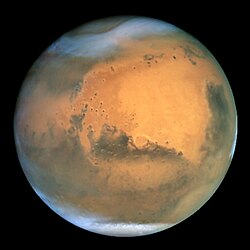Mariner 4
 Mariner 4 | |||||
| Status | Uppdraget slutfört | ||||
|---|---|---|---|---|---|
| Typ | Förbiflygning | ||||
| Program | Marinerprogrammet | ||||
| Organisation | NASA | ||||
| Större entreprenör | JPL | ||||
| NSSDC-ID | 1964-077A[1] | ||||
| Uppdragets varaktighet | 3 år, 23 dagar | ||||
| Uppskjutning | |||||
| Uppskjutningsplats | Cape Canaveral LC-12 | ||||
| Uppskjutning | 28 november 1964 | ||||
| Uppskjutningsfarkost | Atlas-Agena D | ||||
| Omloppsbana runt Solen | |||||
| Halv storaxel | 199 591 220 km | ||||
| Excentricitet | 0.17024754 | ||||
| Banlutning | 2,51 | ||||
| Omloppstid | 562,888 dagar | ||||
| Apoapsis | 233 571 130 km | ||||
| Periapsis | 165 611 300 km | ||||
| Förbiflygning av Mars | |||||
| Datum | 15 juli 1965, 01:00:57 UTC | ||||
| Minsta avstånd | 9 846 km | ||||
| Egenskaper | |||||
| Massa | 260,68 kg | ||||
| Effekt | 170 W | ||||
| Kronologi | |||||
| |||||
Mariner 4, en interplanetarisk rymdsond byggd av den amerikanska rymdflygsstyrelsen NASA, var den fjärde i en serie om 12 planerade sonder (sedermera 10 då de två sista sonderna döptes om till Voyager) i Marinerprogrammet.
Huvuduppdrag
Sonden sköts upp den 28 november 1964 med planeten Mars som mål. Väl framme var ett av målen att ta bilder av Mars yta, vilket sonden gjorde i juli 1965.[1] Total mängd tillbakasänd data var cirka 634 kB, varav det mesta utgjordes av 22 bilder.
Källor
Fotnoter
- ^ [a b] ”NASA Space Science Data Coordinated Archive” (på engelska). NASA. https://nssdc.gsfc.nasa.gov/nmc/spacecraft/display.action?id=1964-077A. Läst 24 mars 2020.
| ||||||||||
| ||||||||||||||||||||||||||||||||||||||||||||||||||||||||
Media som används på denna webbplats
Mariner 4 image, the first close-up image ever taken of Mars. This shows an area about 330 km across by 1200 km from limb to bottom of frame, centered at 37 N, 187 W. The area is near the boundary of Elysium Planitia to the west and Arcadia Planitia to the east. The hazy area barely visible above the limb on the left side of the image may be clouds. The resolution of this image is roughly 5 km and north is up. (Mariner 4, frame 01D).
NASA's Hubble Space Telescope took the picture of Mars on June 26, 2001, when Mars was approximately 68 million kilometers (43 million miles) from Earth — the closest Mars has ever been to Earth since 1988. Hubble can see details as small as 16 kilometers (10 miles) across. The colors have been carefully balanced to give a realistic view of Mars' hues as they might appear through a telescope. Especially striking is the large amount of seasonal dust storm activity seen in this image. One large storm system is churning high above the northern polar cap (top of image), and a smaller dust storm cloud can be seen nearby. Another large dust storm is spilling out of the giant Hellas impact basin in the Southern Hemisphere (lower right).
Photo of Mariner crater on Mars taken by Mariner 4
Picture of Mariner 3 or 4.
Mariner 5









